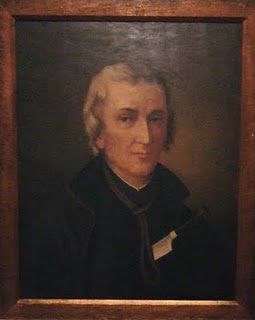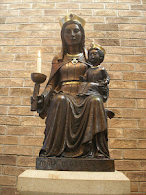The following notice was published in the South Wales Argus on 11th December 2017.
"Sisters of St Joseph Sister M Canisius Walsh Peacefully on 6th December Sister M Canisius Walsh at St Joseph's Convent, Llantarnam Abbey aged 93 years. Funeral Mass 11am Wednesday 13th December in Llantarnam Abbey Chapel. Burial afterwards in Abbey Cemetery. Family flowers only. Further enquiries to Phillip Tom and Sons, Pontymister. Tel: 615005."
For the canonisation of St David Lewis in 1970, Sr Canisius composed a beautiful hymn in his honour. The hymn is still sung today whenever the faithful gather to remember the Abergavenny born Jesuit, Fr David Lewis. He was arrested at Llantarnam in November 1678 and was executed for his faith at Usk in August 1679.
In memory of Sr Canisius, we post here the words of her hymn, which is sung to the tune of 'Hyfrydol'.
Holy Martyr, David Lewis,
Monmouth County's glorious Saint.
Father of the Poor they named you,
When you lived and toiled in Gwent.
Priestly work was undertaken,
Danger-fraught from dawn till dusk.
Gladly still you served your people,
Till you died for them at Usk.
From your capture at Llantarnam,
Through your time in Monmouth Gaol,
Threats and tortures could not shake you,
For your faith would never fail.
Bravely then you faced the gallows,
Crudely fashioned for your death,
Further torment someone spared you,
Till you drew your latest breath.
Great and glorious David Lewis,
Staunch and steadfast in the strife,
Bless your people here in Monmouth,
Those for whom you gave your life.
Help us to be strong, courageous,
Loyal to our loving God,
To Him then will glory flourish,
In the places you have trod."
"HYMN IN HONOUR OF SAINT DAVID LEWIS
Holy Martyr, David Lewis,
Monmouth County's glorious Saint.
Father of the Poor they named you,
When you lived and toiled in Gwent.
Priestly work was undertaken,
Danger-fraught from dawn till dusk.
Gladly still you served your people,
Till you died for them at Usk.
From your capture at Llantarnam,
Through your time in Monmouth Gaol,
Threats and tortures could not shake you,
For your faith would never fail.
Bravely then you faced the gallows,
Crudely fashioned for your death,
Further torment someone spared you,
Till you drew your latest breath.
Great and glorious David Lewis,
Staunch and steadfast in the strife,
Bless your people here in Monmouth,
Those for whom you gave your life.
Help us to be strong, courageous,
Loyal to our loving God,
To Him then will glory flourish,
In the places you have trod."
Rest in peace Sr Canisius.



























.JPG)

.JPG)



.JPG)

